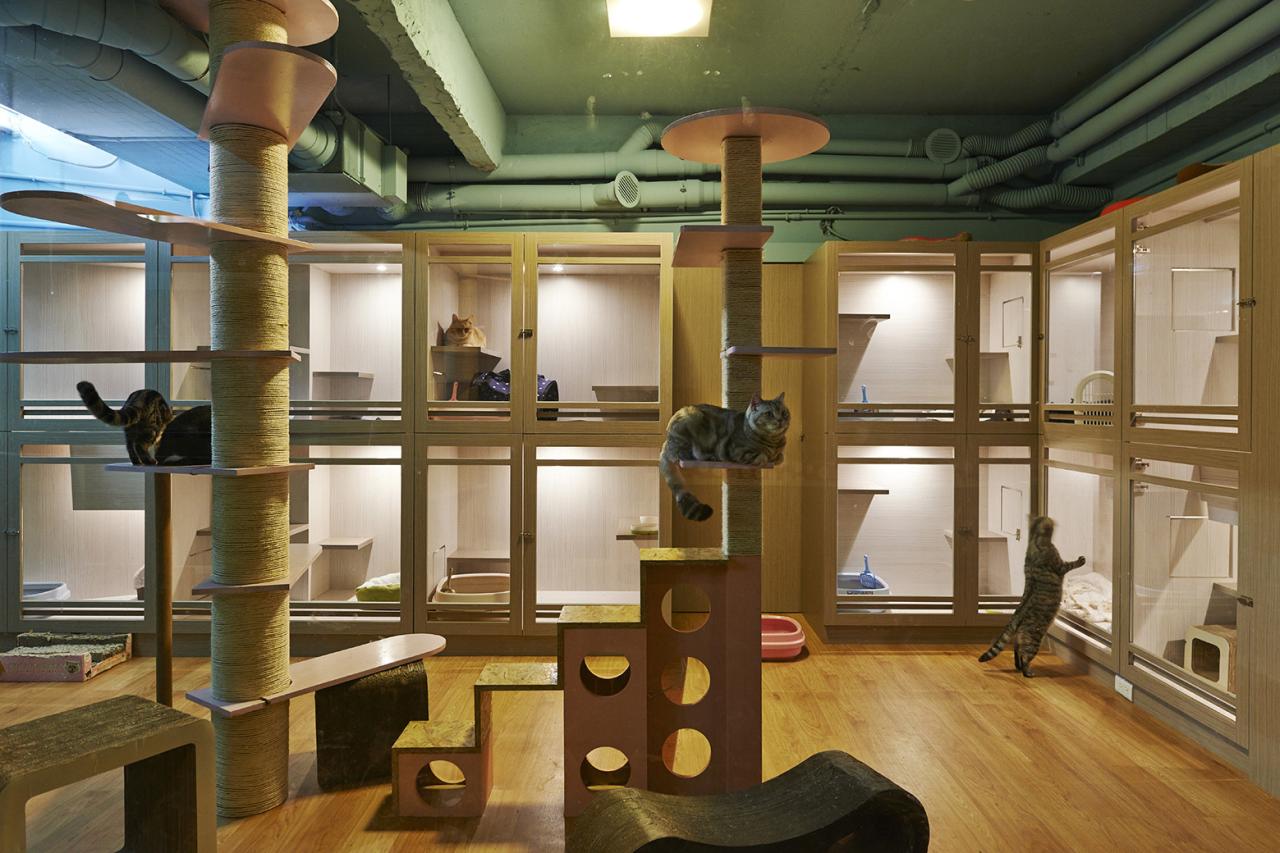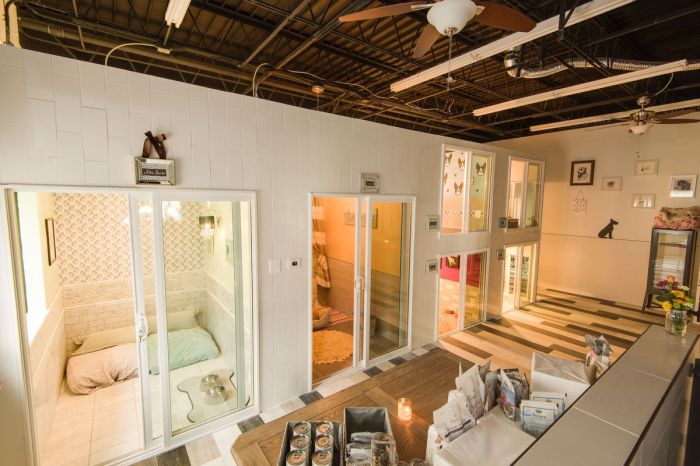
The burgeoning trend of pet-friendly travel has revolutionized the hospitality industry. No longer are pet owners limited to cramped roadside motels; a growing number of hotels now cater specifically to the needs of both humans and their furry, feathered, or scaled companions, offering a range of amenities and services designed to ensure a comfortable and enjoyable stay for all.
This guide delves into the world of hotel rooms designed for pets, exploring everything from defining “pet-friendly” to the legal and logistical considerations involved.
From budget-conscious options to luxurious getaways, the choice of pet-friendly accommodations is expanding rapidly, reflecting the increasing importance of pets in our lives. Understanding the nuances of pet policies, available amenities, and the marketing strategies employed by pet-friendly hotels is crucial for both travelers and the hospitality sector itself. This exploration will provide insights into best practices, potential challenges, and future trends in this dynamic market segment.
Amenities and Services for Pets

Offering pet-friendly amenities is becoming increasingly important for hotels aiming to attract a broader range of guests. A welcoming environment for pets can significantly enhance the guest experience and contribute to positive reviews, ultimately boosting the hotel’s reputation and occupancy rates. However, it’s crucial to carefully consider both the benefits and potential drawbacks before implementing such services.
Pet Amenities Offered by Hotels
Many hotels now provide a range of amenities specifically designed for their furry guests. These commonly include comfortable pet beds, food and water bowls, waste bags for convenient cleanup, and designated areas for pet relief, such as small grassy patches or designated walking routes. Some hotels even go the extra mile, offering pet-sitting services, grooming facilities, or even welcome gifts for pets.
The level of amenities provided often correlates with the hotel’s overall pricing and target market. Luxury hotels, for example, may offer more extensive services than budget-friendly options.
Benefits and Drawbacks of Offering Pet Amenities
From a hotel’s perspective, offering pet amenities presents both advantages and disadvantages. The benefits include attracting a wider customer base, including pet owners who may otherwise choose a different accommodation, leading to increased occupancy and revenue. Positive online reviews mentioning pet-friendly services can also significantly improve the hotel’s reputation and marketing appeal. However, providing pet amenities involves costs associated with purchasing supplies, maintaining designated areas, and potentially hiring additional staff for pet-related services.
There’s also the risk of damage to rooms or property caused by pets, necessitating increased cleaning and maintenance expenses.
Potential Risks Associated with Allowing Pets
Allowing pets in hotel rooms introduces several potential risks. Damage to property, such as scratches on furniture or stains on carpets, is a significant concern. The potential for allergies among guests is another major factor. Hotels must carefully manage these risks through thorough cleaning protocols, robust damage assessment procedures, and clear policies regarding pet behavior and responsibility.
They may also need to offer alternative accommodations for guests with severe allergies. Thorough training for staff on handling pet-related issues is also crucial to minimize potential problems.
Innovative Pet Amenities to Enhance Guest Experience
To further elevate the pet-friendly experience, hotels can explore innovative amenities.
- Pet Tech Integration: Smart feeders and water dispensers that can be controlled remotely, offering guests peace of mind while away from their rooms.
- Specialized Pet Services: Partnerships with local dog walkers or pet groomers to offer convenient on-site services.
- Pet-Friendly Activities: Creating curated itineraries for pet owners, suggesting local dog parks, hiking trails, or pet-friendly restaurants.
- Elevated Comfort: Offering a selection of high-quality pet beds and toys, catering to different pet sizes and breeds.
- Allergen-Conscious Rooms: Designating specific rooms or floors as allergen-free to accommodate guests with sensitivities.
Marketing and Advertising Pet-Friendly Hotels

Successfully marketing pet-friendly hotels requires a targeted approach that resonates with pet owners’ priorities and concerns. This involves highlighting the unique benefits offered to both humans and their furry companions, utilizing various marketing channels, and employing compelling visuals to showcase the experience.
A Marketing Campaign Targeting Pet Owners
This campaign will focus on the emotional connection between pet owners and their animals, emphasizing the importance of including pets in travel plans. The campaign will use heartwarming imagery and testimonials to build trust and demonstrate the hotel’s commitment to pet well-being. The core message will be: “Travel with your best friend – experience a vacation where everyone feels welcome.” This campaign will be launched across various platforms, as detailed below.
Key Features and Benefits to Highlight
Marketing materials should emphasize the convenience and comfort provided to both pets and their owners. Key features include spacious pet-friendly rooms, readily available amenities like pet beds, bowls, and waste bags, nearby pet-friendly parks or walking trails, and potentially even on-site pet services like grooming or walking. Benefits include stress-free travel for pets and owners, the ability to enjoy vacations together as a family, and the creation of lasting memories.
The marketing will specifically address concerns pet owners might have, such as cleanliness and potential pet-related fees, presenting clear and transparent information.
Online and Offline Channels for Promotion
Effective promotion requires a multi-channel strategy. Online channels will include a dedicated pet-friendly section on the hotel website, social media marketing (Instagram, Facebook, TikTok) featuring user-generated content and engaging videos, targeted online advertising campaigns (Google Ads, social media ads) focusing on pet-related s and demographics, and partnerships with pet-related blogs and influencers. Offline channels will involve collaborations with local pet stores and veterinary clinics, participation in pet-related events and expos, and print advertising in relevant publications (e.g., pet magazines, local newspapers).
Effective Use of Imagery to Showcase Pet-Friendly Aspects
High-quality photography and videography are crucial. Images should depict happy, well-cared-for pets enjoying the hotel’s amenities. For example, a photo might show a dog comfortably lounging on a pet bed in a spacious room, or a cat exploring a sunlit window sill. Videos could showcase pets happily playing in a designated pet area or enjoying a walk in a nearby park.
The use of warm, inviting colors and natural lighting will further enhance the positive emotional response. The imagery should consistently convey a message of comfort, safety, and fun for both pets and their owners. Consider showcasing images of hotel staff interacting positively with pets, demonstrating a welcoming and caring atmosphere.
PET-FRIENDLY HOTELS
Offering pet-friendly accommodations presents a lucrative opportunity for hotels, but it also introduces significant legal and safety considerations that must be carefully addressed to mitigate risk and ensure a positive experience for all guests. Failure to do so can lead to legal liabilities, financial losses, and reputational damage.
Legal Aspects of Accommodating Pets
Hotels must comply with local, state, and federal laws regarding animals. These laws may cover areas such as service animal accommodations under the Americans with Disabilities Act (ADA), breed restrictions, pet fees, and liability for pet-related damages. Comprehensive legal counsel is crucial to ensure full compliance. Insurance policies should explicitly cover liability related to pet injuries or damages caused by hotel guests’ pets.
This might include general liability insurance with specific endorsements for pet-related incidents or a separate pet liability policy. Hotels should also maintain detailed records of pet policies, guest agreements, and incident reports to provide evidence of compliance and due diligence in case of legal disputes. The specifics of these regulations vary significantly by location; therefore, seeking legal advice tailored to the hotel’s specific region is paramount.
Safety Protocols for Pet-Related Incidents
Establishing clear safety protocols is essential for handling potential incidents involving pets. This includes procedures for dealing with aggressive pets, allergic reactions to pet dander, and injuries caused by pets. Staff training should cover recognizing signs of aggression in animals, appropriate response techniques (such as maintaining a safe distance and contacting animal control if necessary), and the proper use of any safety equipment (e.g., barriers or cleaning supplies).
A well-defined protocol for handling allergic reactions should include readily available antihistamines or epinephrine auto-injectors (EpiPens) and clear steps for contacting emergency medical services. Furthermore, having a designated area for pet waste disposal and regular cleaning schedules minimizes the risk of health hazards. The hotel should also clearly Artikel the procedures for reporting incidents, including the chain of command and necessary documentation.
For example, a bite incident would require immediate medical attention for the victim, a thorough investigation of the circumstances, and the potential reporting to relevant authorities.
Communication of Pet Policies and Responsibilities
Clear and concise communication is key to a positive experience for both pet owners and non-pet owners. The hotel’s pet policy should be readily accessible on the website and prominently displayed at check-in. This policy should clearly Artikel permitted pets, size and breed restrictions, fees, designated pet areas, and guest responsibilities (e.g., cleaning up after pets, keeping pets leashed in public areas, and reporting any incidents).
The policy should also address liability and potential consequences for non-compliance. Hotels can use various communication channels, such as email confirmations, welcome packets, and signage, to reinforce these policies. Providing guests with a checklist of pet-related responsibilities can further improve compliance and prevent misunderstandings. For example, a checklist could remind guests to bring waste bags, food and water bowls, and to keep their pet on a leash outside of their room.
Creating a Safe and Welcoming Environment
Balancing the needs of pet owners and non-pet owners requires careful planning and consideration. Designated pet-friendly areas, such as specific floors or wings, can help minimize disruption to guests who prefer pet-free environments. Regular cleaning and maintenance of these areas are vital to ensure hygiene and minimize allergens. Hotels can also offer amenities specifically for pets, such as designated walking areas, pet beds, and bowls, to enhance the guest experience.
Communicating the location of these areas clearly to guests is crucial. Signage indicating pet-friendly and pet-free zones can help maintain order and avoid conflicts. Finally, staff training should emphasize courteous and professional interactions with both pet owners and non-pet owners, addressing concerns and resolving issues promptly and effectively. For instance, staff should be trained to politely address a guest who might be uncomfortable with a pet in a common area.
The hospitality industry’s embrace of pet-friendly travel demonstrates a clear understanding of evolving consumer preferences and the growing bond between humans and their animal companions. By offering thoughtful amenities, transparent policies, and exceptional service, hotels can successfully attract a significant segment of the travel market while simultaneously enhancing the overall guest experience. The future of pet-friendly hotels is bright, with continuous innovation and expansion expected in this increasingly competitive yet rewarding niche.
FAQ Guide
What are the typical fees associated with bringing a pet to a hotel?
Fees vary widely depending on the hotel, pet size, and length of stay. They can range from a small nightly fee to a more substantial one-time charge.
Are there any weight or breed restrictions for pets in hotels?
Yes, many hotels have weight and breed restrictions. Some may prohibit certain breeds deemed aggressive, while others may impose weight limits to ensure the safety and comfort of all guests.
What should I do if my pet has an accident in the hotel room?
Immediately notify hotel staff. Most hotels have procedures in place to handle such situations efficiently and maintain a clean environment for all guests.
What if my pet damages something in the hotel room?
Hotel policies regarding pet-related damages vary. It’s advisable to review the hotel’s pet policy carefully before your stay and to report any incidents promptly.




